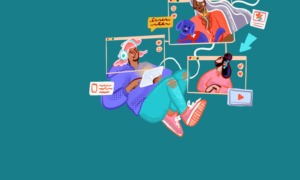 Youth of color experience the worst outcomes in every youth-serving system, including law enforcement, child welfare and education, the data show conclusively. This is due in part to unconscious or implicit biases that affect our understanding of individuals, based on their race and ethnicity, and cause us to alter our decision-making accordingly.
Youth of color experience the worst outcomes in every youth-serving system, including law enforcement, child welfare and education, the data show conclusively. This is due in part to unconscious or implicit biases that affect our understanding of individuals, based on their race and ethnicity, and cause us to alter our decision-making accordingly.
As decision-makers we are often oblivious to our own biases and the pervasive patterns of discrimination that exist within our agencies and institutions.
Many people reject the idea that race and ethnic disparities in youth-serving systems are caused by racism or bias. That’s because they think of racism only in terms of blatant acts of discrimination such as lynching, cross-burning and Jim Crow segregation.
In the absence of those more blatant and incontrovertible examples of racism, many people think that the racism that may exist is the result of the random acts of a few bad apples.
But in this post-civil rights era racism has not disappeared. It has merely been transformed by colorblind practices that preclude us from noticing or talking explicitly about racism. By making conversations about race and racism taboo, colorblindness can mask the myriad ways that race and racism function today.
Modern racism is reflected in everyday behaviors in the form of microaggressions, e.g., verbal, nonverbal and environmental slights, snubs, insults, intentional or unintentional, that communicate hostile, derogatory or negative messages that can have a detrimental racial effect and can remain virtually invisible in a colorblind society.
Such behaviors can go undetected in part because of their subtlety. They allow the modern racist to argue they have no bearing on race whatsoever.
When one juvenile court judge stated he wouldn’t tolerate discrimination from anyone in his court, he was clearly expecting the racism would be tangible, easy to detect, not everyday behaviors from everyone in juvenile court, reflected in the differential application of policies and procedures and passed from one decision-point to the next.
In this way bias that is deeply entrenched in cultural norms of the agency and society can persist, virtually without notice.
Racism reflected in patterns of racial discrimination in every social institution is caused by more than the random acts of a few “bad apples.” Instead, it comes from the collective acts of individuals whose decisions are consistent with biases that are widely held throughout society, even by well-meaning people.
What is implicit bias?
According to the National Center for State Courts, “implicit bias is the bias in judgment and/or behavior that results from subtle cognitive processes (e.g., implicit attitudes and implicit stereotypes) that often operate below conscious awareness and without intention.” Explicit bias “reflects the attitudes or beliefs that one endorses at a conscious level.”
People make automatic associations between individuals and their stereotypical group characteristics due to implicit biases. We are inundated daily by messages throughout popular culture, e.g., news media, talk shows, reality TV, political speeches, comedy acts, movies, textbooks and jokes, that promote stereotypical images of all race and ethnic groups.
When I ask practitioners across the country about stereotypes, regardless of whether they live in Orange County, California, or Memphis, Tennessee, they recite the same stereotypes: Native Americans are alcoholics, blacks are criminals, Asians are smart and Mexicans are undocumented.
On a conscious level, we would avoid generalizing about groups in this way, but because implicit biases operate on an unconscious level, we can be caught off-guard by these stereotypes, which affect our daily decision-making.
The reason disparities in decision-making can go unnoticed is because biased decision-making creates a vicious cycle: In youth-serving systems, the more consistently decisions match the stereotypes, the more they are replicated within the agency and society in general; the more correct and natural the decisions appear; the less scrutiny they will undergo, and the more likely the outcomes — good or bad — will be used as the basis for later decisions.
Biases in decision-making have the potential to inform and therefore distort decisions at each step along the way. In this way biases and corresponding decisions become a normal aspect of agency and societal culture. The stereotypes that associate blacks with criminality and whites as basically neutral or good cause us not to notice or question the overrepresentation of blacks in juvenile justice and the relative underrepresentation of whites.
Decision-makers often don’t notice the discrepancies in their decisions because they think of themselves as well-meaning people who do not have racial animosity toward others.
But decision-makers in every youth-serving system are susceptible to bias that contributes to disproportionality because:
- racism doesn’t (necessarily) show malice;
- racist attitudes and actions are often unintended;
- racist attitudes can be unconscious, and
- modern racism occurs in the form of microaggressions.
Racism doesn’t show malice
Individuals think that because they don’t feel any racial animosity toward another group, they are not biased. The assumption that teachers, social workers, judges, police and probation officers are unbiased must be challenged because even individuals who “claim no prejudice” against blacks (or people of color in general) “discriminate in subtle but consequential ways.”
Racist attitudes can be unintended
According to colorblind ideology, the litmus test for racism is intentionality. Asserting that statements or actions can’t be racist unless they were “intended” as such will protect even the most obvious racist actions. In fact even though people don’t intend to be racist or are unaware of their biases, their actions can have a racial effect.
We all have unconscious biases
Perhaps the most perplexing aspect of contemporary racism is unconscious or implicit bias. Our implicit biases will affect our decision-making whether we realize it or not. It affects our perceptions, the way we interpret the facts and the language we use to describe the “facts.” Anyone can be affected by bias; teachers, judges, law enforcement, probation officers, hospital staff, etc. Despite our best intentions, “few can escape the cultural and cognitive forces that promote racial bias.”
Racism in institutions occurs in the form of microaggressions and rarely as blatant and incontrovertible acts of discrimination.
How implicit bias can preserve systems of inequality
Race and ethnic stratification that existed prior to the civil rights movement persists today, more than 30 years after the historic laws of racial exclusion were ostensibly eliminated. This is true in part because implicit bias distorts how facts are interpreted, resulting in vastly dissimilar outcomes in identical circumstances.
Implicit biases can distort the assessment of a youth’s delinquency, dangerousness and their risk of reoffending. That can result in the detention of one youth for the identical offense for which another was released. In child welfare, white and black children with identical risk factors have different outcomes: White children are more likely to receive family in-home services and black children are more likely to be removed and placed in foster care.
In hospitals and emergency rooms, the attitude of the mother can be perceived as evidence of risk to the child. White families are expected to advocate on behalf of their children but advocacy by black parents can easily be perceived according to stereotypes, e.g., aggressive, hostile and “poor parenting skills.”
These stereotypes and corresponding implicit biases can cause child welfare and hospital staff to judge black parents as uncooperative with decision-makers and therefore working against the best interest of their children. When decision-makers perceive families or youth as uncooperative, that perception is likely to be encoded into case notes, affidavits and court records.
Racially coded language recorded in reports are shared and passed from one decision point to another within and between systems. Judges have stated that as they became more aware of implicit bias they could identify how language in court reports signify race.
For example, in cases where decision-makers can use the benefit of the doubt to render a decision involving drug use, a white mother is often reported as having “no drug involvement,” whereas a black mother is reported as “mother alleges” or “mother reports no drug involvement.” It is easy to see how the use of racially coded language creates bias at one decision point that gets passed to another.
Based upon the choice of words, one mother has essentially been cleared of suspicion of drug involvement while another is placed under greater scrutiny and will have a hurdle to overcome. Bias encoded in language becomes the baseline for decision-making at every subsequent decision point and will impact how children and their families are perceived and therefore how they are served within systems.
Because implicit bias can easily go undetected, usual practices that appear neutral to race must be examined for their potential to promote and mask biases.
How implicit bias interacts, compounds within, across youth-serving systems
Implicit bias can:
- Inform discretionary decision-making, assessments of risk and reoffending, and how sentences and adjudication are determined.
- Result in the differential application of policies and procedures; for example, identical offenses can be perceived and managed differently due to differences in perception caused by implicit biases.
- Contribute to how discretionary laws and policies are applied and enforced, such as arresting preschool children who are having tantrums and labeling their age-appropriate behaviors “outbursts of violence.”
- Affect the language we “choose” and language we read in reports and affidavits, e.g., labeling white mothers as “upset” and black mothers as “angry” in identical circumstances. Bias in the use of language can affect decisions resulting in detention in juvenile justice or removal or reunification in child welfare.
- Inform ambiguous charges of delinquency such as willful defiance (bad attitude, rolling eyes, using profanity), or discretionary charges of low-level offenses like jaywalking or indecent exposure (e.g., sagging pants), which can be the reason some youth have increased contact with the system while others who commit similar offenses do not.
Rita Cameron Wedding, Ph.D., is the chair of the department of Women’s Studies and a professor of Women’s Studies and Ethnic Studies at Sacramento State University. Her curriculum “Implicit Bias: Impact on Decision-Making,” has been used to train judges, public defenders, practitioners in child welfare, juvenile justice, law enforcement and educators since 2005. As faculty member for the National Council of Juvenile and Family Court Judges, she has trained judges at court improvement initiatives in 40-plus states. She has provided expert testimony before the U.S. Commission on Child Abuse and Neglect Fatalities. Email her at drrcamwed@aol.com.
More related articles:
OP-ED: Systemic Racism Overwhelms Our Culture
OP-ED: Fraternity Chant Shows How Racism Infects Organization
Listen to the White Southerner: Zero Tolerance in Schools Is Racist
































